Si Phan Don: Laos’ land of lotus eaters is 4,000 islands of bliss on the mighty Mekong
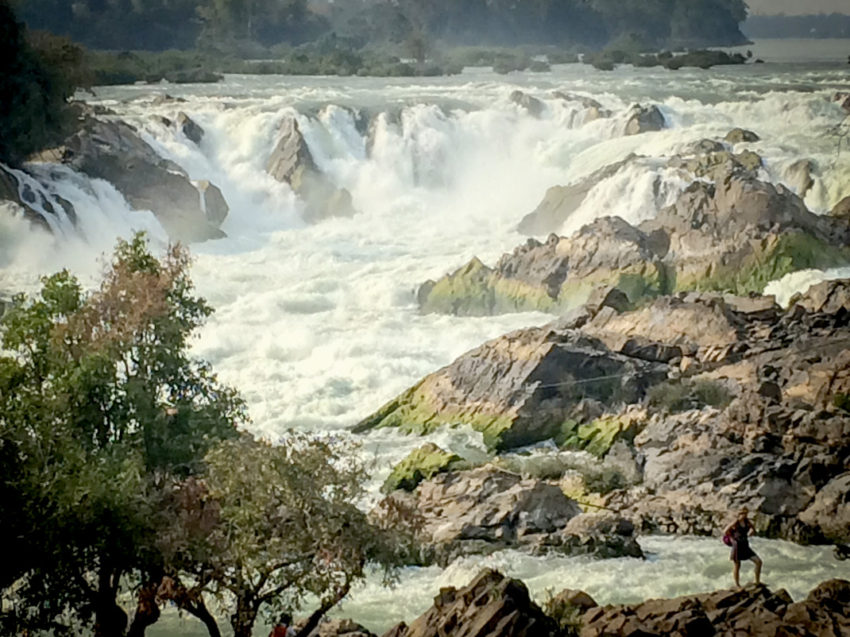
DON KHON, Laos — It took three days to travel from the northern tip of Laos to the southern tip. From what’s in front of me, it looks like I went from the tip of North America to the heart of the Amazon Jungle.
I’m sitting on my bungalow’s terrace staring out at the Mekong River. Birds are singing. A lone motor boat slowly buzzes by, its motor more soothing than irritating. Even the lone crowing rooster doesn’t feel so annoying here. Across the water is a string of palm trees, standing sentry to one of the most tranquil corners of Southeast Asia. I’m on Don Det, one of the islands of Si Phan Don. That’s Lao for “4,000 Islands,” a name I didn’t doubt the moment my motor boat maneuvered around dozens of them to arrive here.
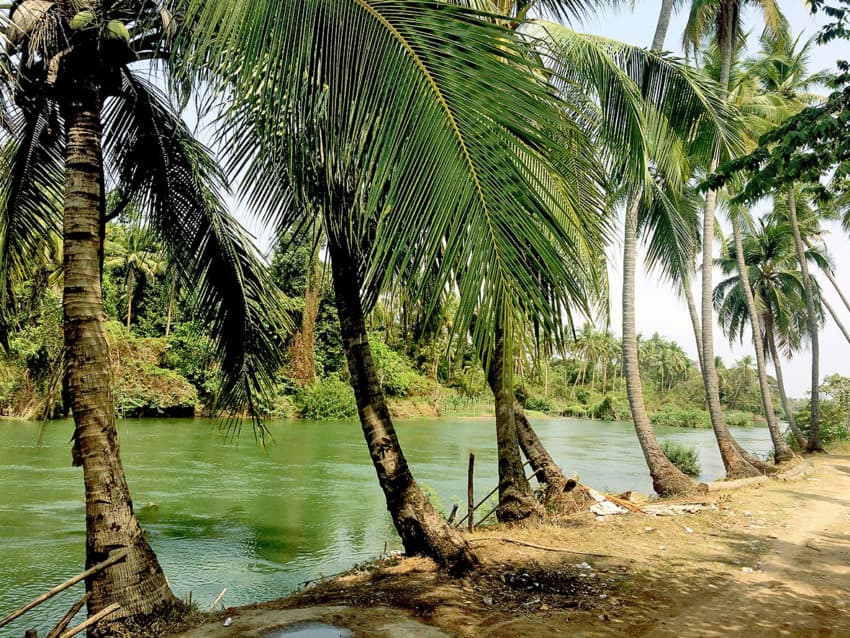
The Mekong River, which stretches 2,600 miles from the southern tip of Vietnam to northwest China, is nowhere wider than it is right here. In the rainy season in spring, it stretches eight miles. I’ve been on the Amazon which stretches 30 miles wide in some places and seems more like an ocean than a river. But the Amazon doesn’t have 4,000 islands. They are sprinkled around this archipelago like potted plants. The crude longboat that carried me from the port town of Ban Nakasang maneuvered through islands no bigger than a schoolyard. But each one has a little pod of trees, like individual gardens. We passed the occasional fisherman. Water buffaloes bathed in the shallows. That was about it.
Of the 4,000 islands, two are the main destinations of travelers. Don Det is slowly becoming party central in southern Laos and has become a beacon for aficionados of baked marijuana goods. Nearby Don Khon is where one goes to get away from it all — or crash after too many baked marijuana goods. While sitting in the bottom of a cramped longboat, steaming through the mountains of northern Laos, I dreamed of a hammock, a book and a beer by the river. Brushing against my knee as I’m writing this is a hammock. On the table next to me is “The Coroner’s Lunch,” Colin Cotterill’s dark novel set in Laos. In the trash can in the corner is an empty Beerlao can, the first of many that will be consumed on this patio.
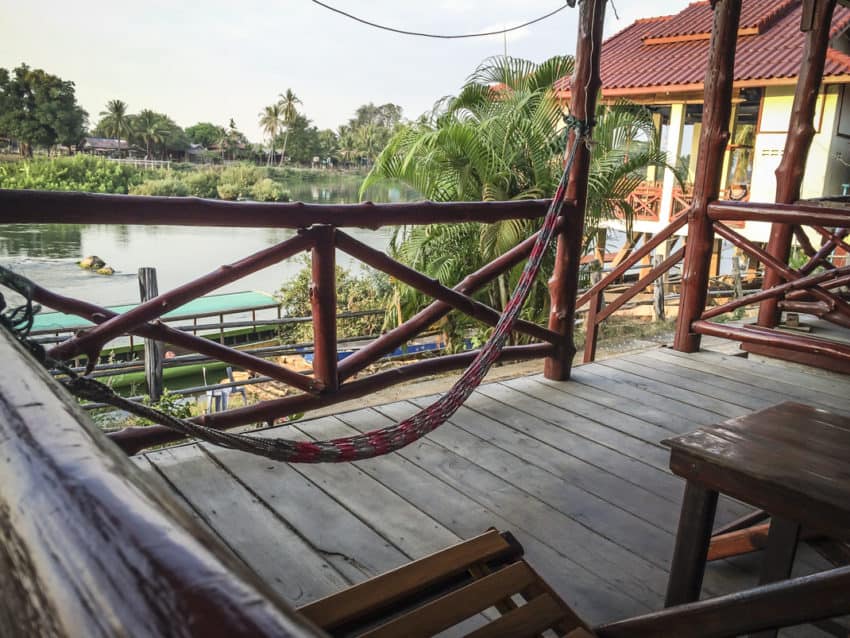
Who knew heaven wasn’t in the sky but in a corner of Southeast Asia?
My bungalow is at Pam’s Guesthouse, run by a pretty middle-aged woman who doesn’t speak a word of English. It’s in a row of seven identical rooms, all facing the water, with stained bamboo surrounding the quaint patios. The room has two beds, both with tied-up mosquito nets and a large, clean bathroom and hot showers. A minibar chilled my beer and free bottles of water to Arctic lows in minutes.
Cost: $26 a night including breakfast. That’s expensive for Laos. That’s VERY expensive.
The energy I thought would be sapped from five straight days of hard traveling — trekking, motorboats, cramped buses — returned. I took a quick shower, raced to Pan’s kitchen, took a beer and came back to my patio. I drained the ice cold beer as the sun set behind the swaying palm tree to my left. I immediately fell asleep, looking like a bad drunk, passed out next to an empty beer bottle. I woke up to a pitch black night. I had to fumble to find my door.
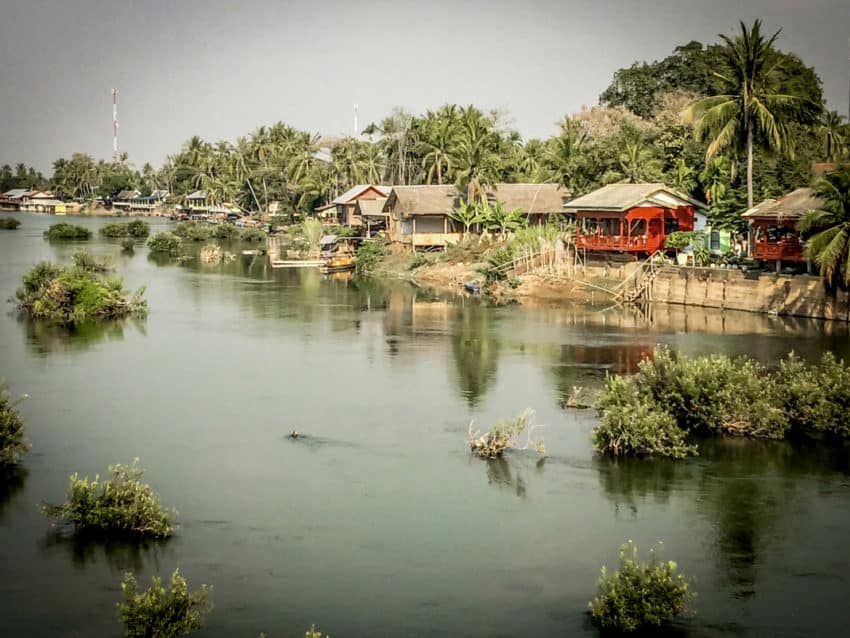
But this is the land of lotus eaters. That’s a pretty white flower which covers the islands and puts your mind in a state where exertion and stress are as foreign as parkas and five-star hotels. Before exploring the Mekong by kayak, my itinerary will consist of breakfast and a hammock with a book on my chest. Life doesn’t move fast in Si Phan Don. Neither will I.
***
The Mekong River is the 12th longest in the world. It’s the 10th largest in water volume. It seems like I kayaked most of it in one day. At least my abs and upper legs feel like I’ve gone to northwest China and back. In reality, I only went four hours with lots of breaks. But I don’t remember being so thankful to see a muddy dock as I was when the sun set on southern Laos.
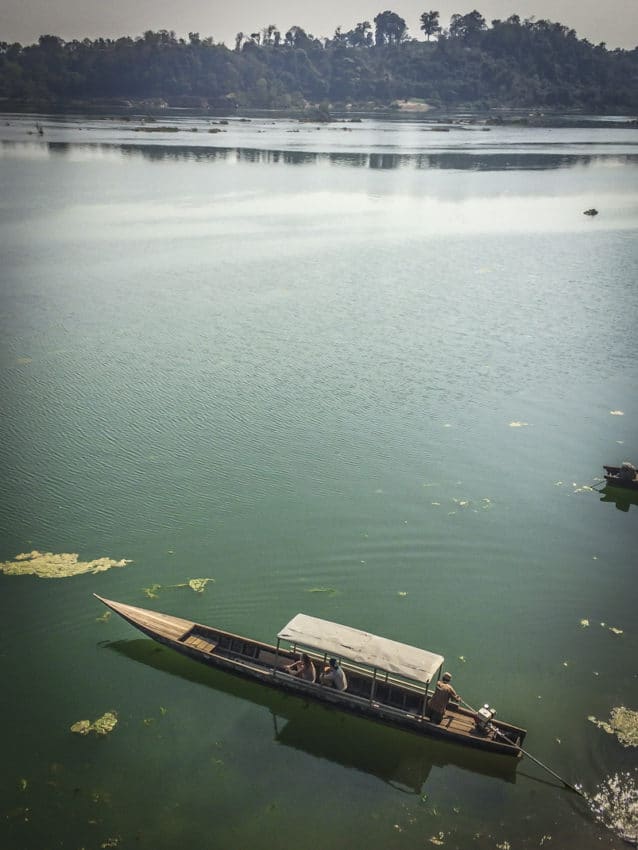
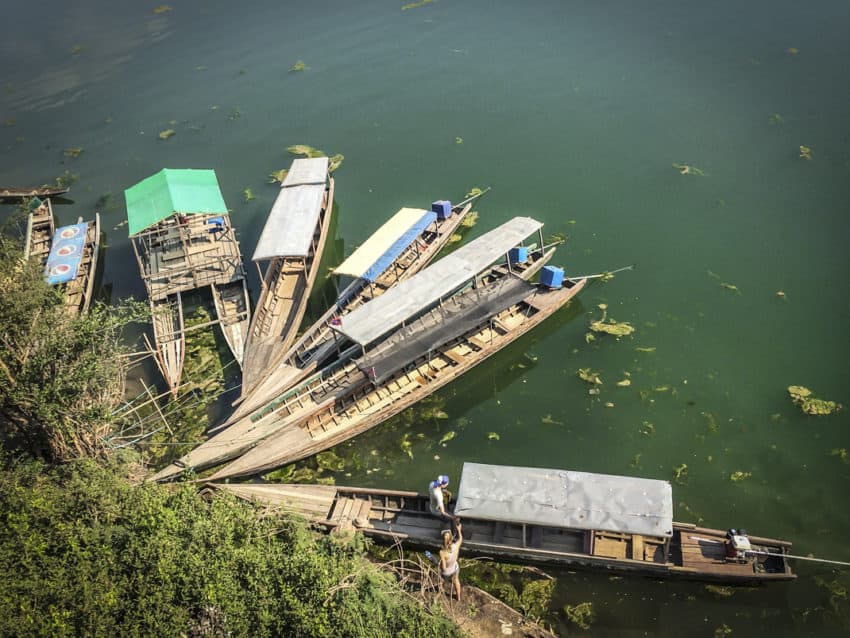
It was the needed completion of research for my story on adventure travel in Laos. If ziplining is the best way to see the karsts, kayaking is the best way to see the Mekong. Nowhere is the Mekong more powerful or beautiful than it is in this corner of Southeast Asia. I’m familiar with this river’s history. I once took a slow boat from Ho Chi Minh City to Cambodia. In that 180-mile stretch, the Mekong is the color of a soldier’s uniform after a month in “the shit.” It’s dirty brown, seemingly too thick for fish to swim let alone spawn. And hot? If I was a soldier during the Vietnam War, forget the Viet Cong. The heat would’ve killed me much sooner. I would’ve thrown myself on the horns of one of the water buffaloes who were forever soaking their massive bodies.
The water buffaloes I passed here looked positively happy. They swam in the water with their little snouts just above the surface. They shook water from their heads. They seemed to play.
The day started at my guesthouse where I met two young German women, Ramona, 28, and Tanya, 34, who signed up for the same kayak tour. We piled into a rickety longboat for a trip across to Don Det. We were led to a large guesthouse patio packed with travelers digging into the buffet breakfast.
Everyone here was on our trip.
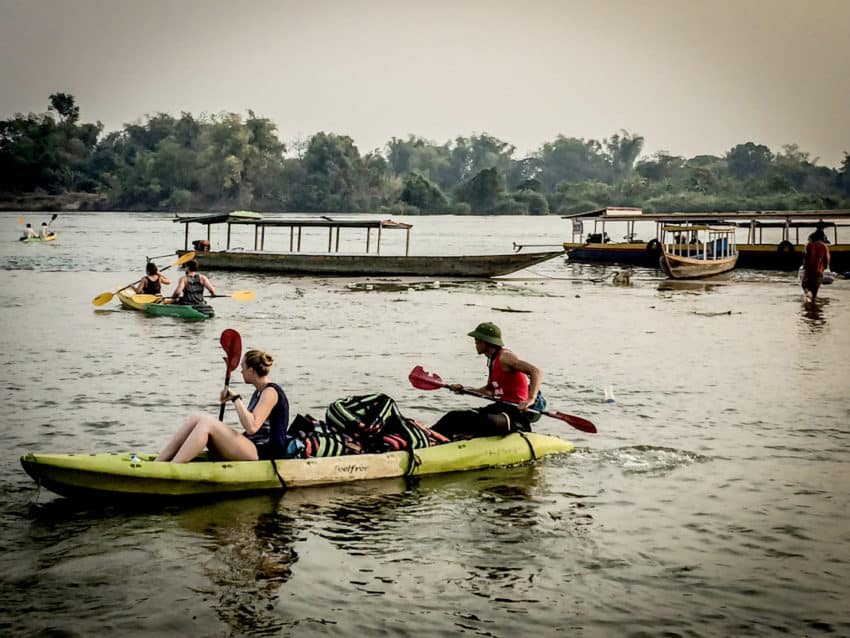
I was teamed with a little French girl whose name I couldn’t pronounce after three tries. Mirriam or Mirrim or Mirriamaman had just graduated from university and was traveling for three months. In a giant procession of 30 people, we all meandered down a muddy river bank where a squadron of kayaks awaited us. Calling these boats kayaks is like calling three-wheeled tuk-tuks limousines. The boats are big flat-bottom plastic boats with small insets for your butt and feet. There is virtually no back support. They are nothing like the one-man vessels where you’re tied in with the back firmly against the opening. To paddle, you must bend at the waist and rotate your arms over and over. Or, if you’re as inflexible as a week-old baguette like I am, you lay flat on your back and do it. I looked like a guy flying a kite from a hammock. However, sitting up for more than a few minutes had me nearly gasping for breath. About a dozen yoga lessons did nothing but convince me I’ll never be flexible — or a kayaker.
However, the scenery was unbelievable. The Mekong is Si Phan Don. You have to get in it to see it. We started and went out in the open water. We passed little green pods, the occasional boat with fishermen in conical hats, a bird in a tree sunning himself in the steamy heat. Miriam, or whomever, and I were a terrible team. She wasn’t terribly athletic; I’m not terribly flexible. Even with a shoddy, leather back brace on my rear seat, I couldn’t sit up for more than a few minutes. Laying back destroyed my leverage and we languished behind the small navy steaming upriver. My competitiveness and growing fatigue made me nearly forget the spectacular scenery around me. I vaguely remember the birds’ singing above, the lone fisherman’s motorboat or the water buffaloes chortling at our plodding kayak.

We finally docked and walked through a dusty village of stilted wooden houses where barefoot children ran up and gave us high fives. We descended a very precarious wooden staircase down a muddy river bank to a long rocky outcrop that served as a bathing area. To our right were Tat Somphamit. Known around here as Li Phi Falls, they were a countless collection of rapids that came cascading over a large collection of rock formations. The white water formed into a sea green stream that meandered past us as we sat resting in the sun. Some dangled their feet in the rapids. Other crazy Frenchmen risked broken ankles climbing to the top of the rocks. I found total bliss sitting in the middle of a rapid on the side, the pouring water gushing over my shoulders and down my legs, some of the water getting into my shorts. I had no intention of moving.
It was very cliquish. The French stayed with the French, the Germans with their Teutonic friends, the English-speaking Brits and Canadians stuck together. They all came from Don Det, the party island from where they compared the potency of marijuana cookies with marijuana pizza. (For future reference, fellow travelers, it’s pizza hands down.)

After a decent lunch of shish kabob and rice, we got back in the boats. This time one of the diminutive Lao guides got in mine. I took it as probation for falling so hopelessly behind the pack. He made some reference about upcoming rapids but even Lao know not to insult customers’ manhood. We paddled for about 30 minutes until we reached the widest part of the Mekong we’d seen. We were in a stretch of about three miles wide near the Cambodian border. We rested. I had no idea why but I didn’t complain. My upper legs cramped from pressing against the footholds for leverage. My back felt like I slept on a concrete floor for a week. I laid back, put my feet in the water and slowly splashed water on my face and chest. There are worse ways to spend an afternoon than splashing yourself with waters from the Mekong.
Then I heard, “SAW IT! THERE!” I looked up. I forgot. This trip included a dolphin watch. I had previously blown it off. Javy, the Hungarian I trekked with in northern Laos, did this trip and saw nothing. He said Lao officials claim the dolphins all went to Cambodia; Cambodian officials claim they all went to Laos. It was pretty much a given that the dolphins didn’t really exist.
“I think we have a better chance of seeing the Loch Ness Monster here,” I yelled. No one laughed.
Then I heard, “THERE! LOOK!” It was one of the guides. Kayakers were chirping. The dolphins were starting to surface. I kept my eyes peeled and, soon, I saw them. Little dolphins, about three or four feet long were visible. Their sleek, gray bodies and cute eyes were coming up in the water. I saw two. They are Irrawaddy dolphins who look like normal dolphins with elephantiasis. Their heads are bulbous. Their eyes look like buttons. Nevertheless, the dolphins’ seemingly ugly stepchild is considered by islanders as reincarnations of humans with human spirit. Local folklore has Irrawaddy dolphins saving villagers from the jaws of crocodiles. Unfortunately, their numbers have gone from thousands to 60. Apparently, only 10 still inhabit these waters. Lao and Cambodian fishermen are using dynamite and electricity to fish. Even if that isn’t killing the dolphins, they get caught in the nets. Fishermen are reluctant to cut up an expensive net for the sake of a damn dolphin. However, a joint effort by the Lao Community Fisheries and the Dolphin Protection Project is replacing the nets if not the fishermen’s mentality.
The dolphins’ struggle isn’t over. Laos is lousy with dams. I saw seven built on other rivers in northern Laos and until recently, the only dams on the Mekong were in China. Now Xayaburi Dam in northern Laos, schedule to open in 2019, may open the floodgates for more dams, an ironic analogy, I know. The dams have turned Laos into potentially “the battery of Southeast Asia.” Selling electricity for not only its growing population and tourism trade but also to neighbors is huge for Laos, which as recently as the late ‘90s was one of the 10 poorest countries in the world. Now the government is looking to dam more Mekong tributaries. Combine that with the increasing use of pesticides by Lao farmers and I figure I may be one of the last to see these beautiful creatures in the wild.
We paddled to shore again where we were met by an air-conditioned bus that took us along the mainland to one of the most remarkable natural sites in Laos. Khone Phapheng is the largest waterfall in Southeast Asia. It’s not that high — about 70 feet — but it’s huge. It is the confluence of six miles of rapids, which by the time they reach the falls, disgorges 390,000 cubic feet per second. A huge fenced-off viewing area hovers over the falls. Busloads of Thais and South Koreans pour in to take photos and buy ice cream from the frozen bins in the snack bar. In the 1860s, when France tried gaining a toehold in Southeast Asia, French explorers tried building a railroad into China. This waterfall defeated them. The lone trace the French still left is the shell of the rusted locomotive engine on display on Don Khon.
By 4 p.m., everyone was exhausted as we piled into the bus. We were hoping we’d get an AC ride back to our guesthouses. Then we realized we were on the mainland.
“No more paddling,” said one husky Brit, losing his machismo in exhaustion and rising heat.
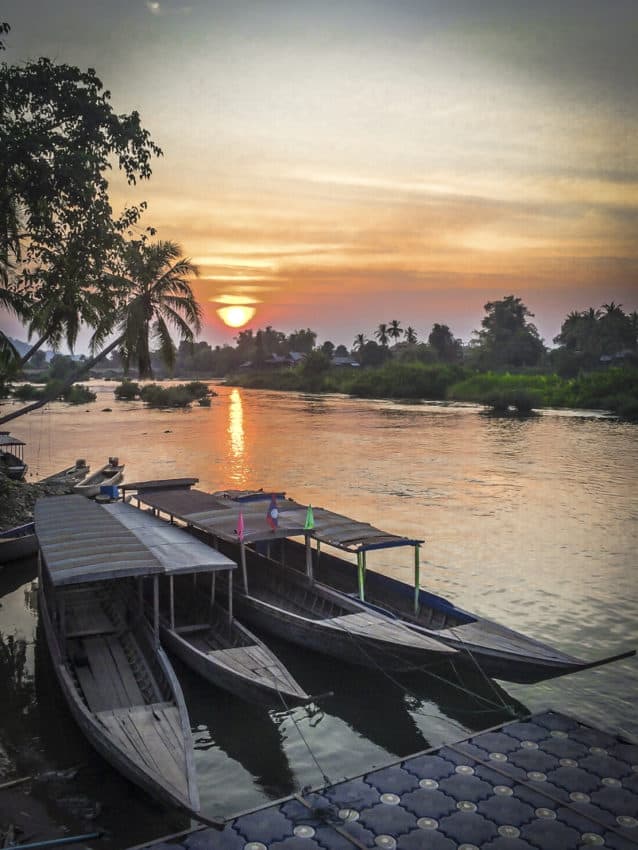
We wound up on the same filthy dock where boats take tourists to the islands. But this time, we piled back into our kayaks and slowly plied our way to Don Det. I was whipped. I paddled for 60 seconds, maybe two minutes, and lay back as if shot by a sniper. Finally, when I saw the crude dock on Don Det, I started my kick. We landed and went up to the landing for a well-earned beer.
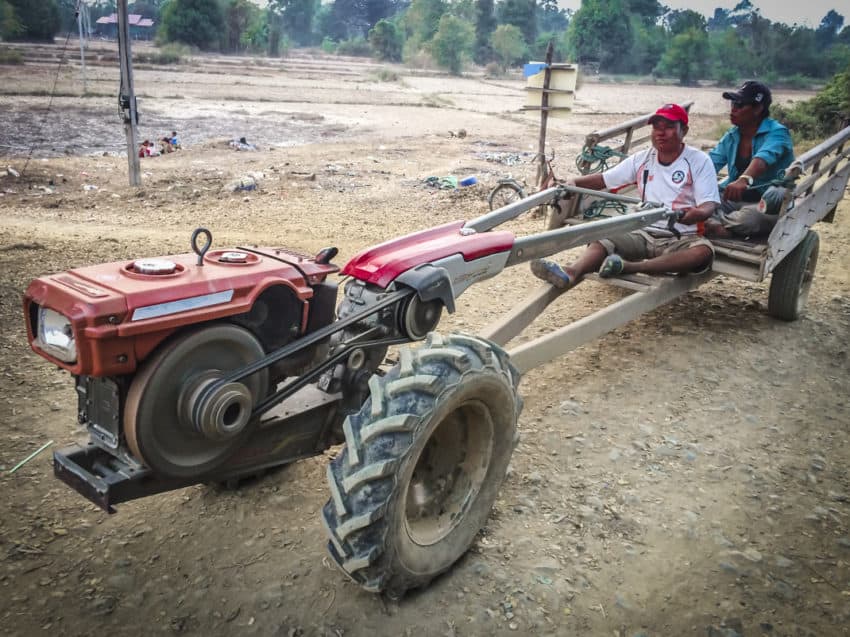
Our adventure wasn’t over. I was the only one in the group staying in Don Khon. Ramona and Tanya were the only ones staying on the other side of Don Det. Our trip included free transfers. No problem. We’d get rides back. Big problem. The ride was in a three-wheel motorized cart with a rickety wooden back end where the three of us rattled around like bags of rice. My back, already sore from sitting up in a kayak for four hours, was chaffed with every bump. It looked like a contraption that tilled rice when it wasn’t shepherding tourists around the island.
Ramona and Tanya became two of the nicer people I’d met. They stayed at the Mekong Guesthouse, a popular backpacker hangout with lots of communal bamboo hammocks. The previous tenant had left a bottle of Lions whisky, a caramel-colored concoction that looked like Johnny Walker except for the “PRODUCT OF LAOS” on the label.
We took a table with two German men: Jo, a straggly, skinny, road-weary guy from, like Tanya and Ramona, a small town in Bavaria, and Constan, a serious, bespectacled guy in his 30s who was from outside Cologne. Over the next four hours we drank shots of Lions mixed with the big bag of ice the tired, dumpy owner, Te, brought to our table. We mixed it with Coke, drank it straight and learned how to properly pronounce “chokdee,” the Lao word for cheers.
Living in teetotalling Rome for three years has dropped my tolerance for alcohol to the level of a 15-year-old boy. So it should come as no surprise that multiple shots of Lao whisky and bottles of beer had me announcing loud enough for the entire guesthouse to hear that Constan held a cigarette remarkably similar to Heinrich Himmler. I didn’t realize until I sobered up the next morning that I was the only one at a table full of Germans who was laughing.
However, we did laugh all night. I even turned my cell phone to “In-A-Gadda-Da-Vida” by Iron Butterfly to show the young Germans what music in my generation sounded like. Kayakers and travelers all drinking heavily and swapping notes of music and love and worlds beyond most imaginations. In the land of lotus eaters, the Mekong not only flows through our guesthouses but our hearts.

